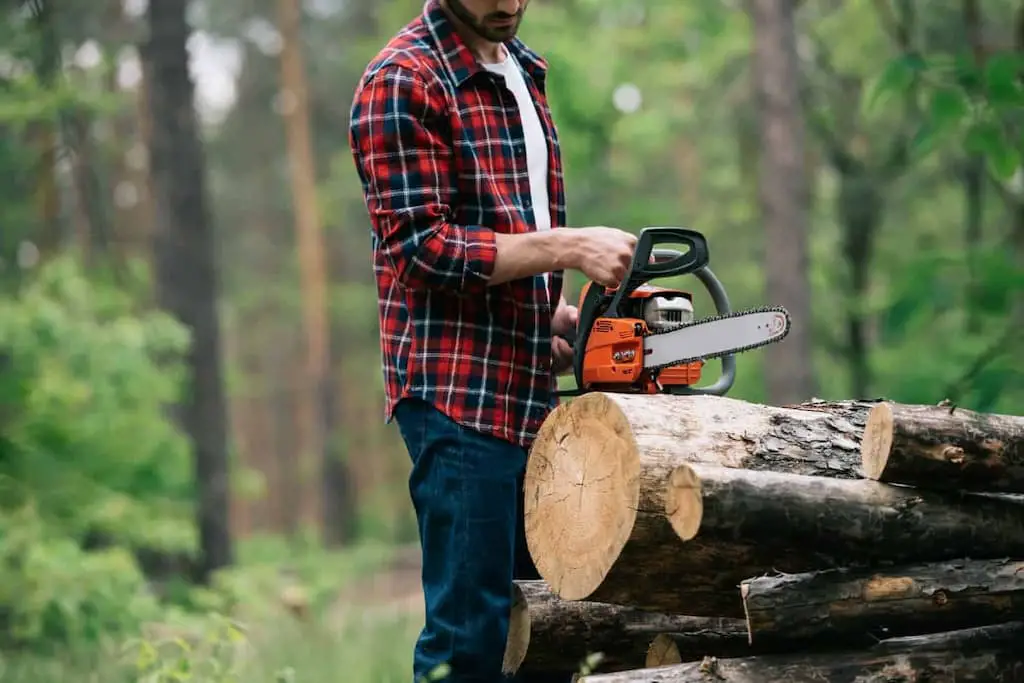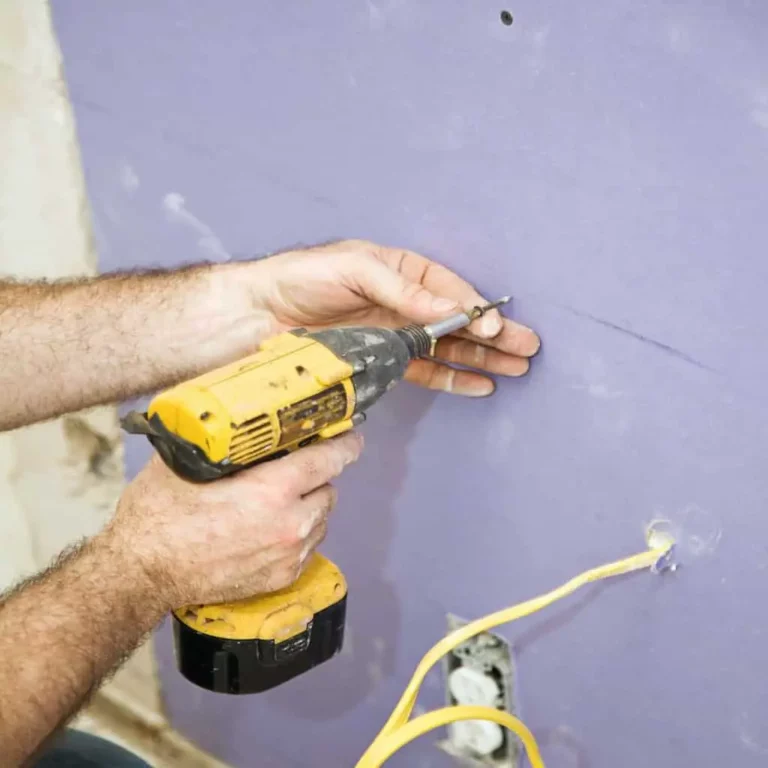How To Store Chainsaw Chains: The Essential Guide

Your chainsaw chains are as important as any other part of the machine. Storing the chains properly after use (or storing extra pieces) is important to maintain its longevity. So, how do you store chainsaw chains?
Here are the essential steps to storing chainsaw chains:
- Clean the chain thoroughly.
- Lubricate the chain’s surface.
- Grab a secure storage box.
- Place the chain in the storage box and seal it.
- Store the box in a safe location.
In this article, I’ll cover all you need to know about storing your chainsaw chains appropriately. I’ll also give you some tips that will help you ensure your stored chains don’t become a tangled mess. If you follow these pointers, you will have clean, sharp, well-organized chainsaw chains on hand when you need them.
- Clean the Chain Thoroughly
The first step to storing your chainsaw chain is to clean out the teeth or blades. Here’s the best way to clean it:
- Mix a cup of ammonia in a gallon of water to get a mixture.
- Carefully remove the chain from the machine.
- Soak it in the mixture.
- Wait for half an hour at least and bring out the chain.
- Scrub the chain with a strong brush, making sure to reach all its corners and crevices.
- Hang it to dry.
If done correctly, the chain should come out looking close to new.
2. Lubricate the Chain’s Surface
Once the chain dries, use a light brush to apply a smear of oil on the blades. Ideally, you should spray the oil on it. This will reduce the chances of rust developing to the barest minimum. You don’t need to use a lot of oil. Just ensure you spray the surface around the chain evenly.
The oiled chain can accumulate dust quickly, so you also need to reduce the chain’s overall exposure to dust. If you must store your chainsaw chain in a dusty environment, you need to ensure the lid is tightly covered at all times. Ideally, you should move the container elsewhere.
3. Grab a Secure Storage Box
As I’ve mentioned above, you can’t store your chainsaw chain by throwing it in the corner of your garage. You need to get a storage box for it. The box the chain came in is often the best option to go with. However, they tend to give way after some time due to handling and accumulation of oil especially.
So, you need to get a container that’s a bit more durable. Any small empty box or tin will do. Some people use Tupperware bowls with lids without any issues. As long as the container can hold the chain and there’s a cover, it will work a lot better than dumping the chain anywhere out in the open.
Once you’ve secured the container, make a storage space for the container in your garage or anywhere you store your tools. I recommend storing it in a lockable cupboard where it’s out of reach of the children or pets.
4. Place the Chain in the Storage Box and Seal It
With oiling done, wait a few minutes and transfer the chain to the storage box you’ve prepared for it. Remember, you have to store the chain in a container with zero chance of moisture reaching it.
This means you shouldn’t put it in an open container and dump it on the floor in a leaking room. Ensure that it’s tightly and completely sealed with a lid. Leaving the container in a place where it can fall into water or outside where there’s a possibility of the container accumulating rainfall (or snow) defeats the storage purpose as well.
5. Store the Box in a Safe Location
Where you store the box is equally as important. You’ll want to ensure it’s located away from pets and children, but is still accessible when you need it.
A well-ventilated room protected from the weather is the best place to store the container holding the chainsaw chain. This should also prevent pests, rust, and excessive dust from accumulating on the chains.
Why Should You Store Chainsaw Chains?
It’s tempting to remove the chainsaw chain after a hard day’s job and then dump it anywhere you want until the next time you need it. However, failing to store your chainsaw chains properly can be dangerous.
You should store your chainsaw chains to prevent accidents and injuries, to keep the blades in top condition, and to prolong the lifespan and effectiveness of the chains.
- To Prevent Accidents
Chainsaw chains contain sharp, tiny blades that can cause serious damage to the flesh if stepped on or touched accidentally. Your pets may be at risk too. Throwing the chains in the corner of the garage may seem like a good idea, but you can never know who will reach into those corners when you’re not around.
Similarly, you don’t want your car or lawn mower tires slashed after running over the chains. Assuming the tires are strong enough to withstand the tiny blades, there’s a chance you’d have a deformed chain that won’t fit on the machine next time you’re ready for a job.
- To Keep the Blades Sharp
A chainsaw chain tossed around will become dull pretty quickly. Firstly, exposing the chains to the elements encourages rust build-up. Over time, this will render the chain unusable. Secondly, a chain exposed to moisture and UV rays can become brittle after a short while. This means the chain will disintegrate next time you try to use it.
So, storing the chains properly is one of the surest ways to ensure the blade will last as long as it should.
- For Better Efficiency
If you’ve ever had to spend time untangling your chainsaw chains, you’ll understand how frustrating it can get. Those extra few minutes you’ll spend on sorting them can be better utilized elsewhere. If you’re on a paid job, that’s time no one will pay for. Imagine working out in freezing weather and trying to untangle chains with your gloves on. Not fun!
Proper storage reduces the chances of that ever happening. You’ll have your chain ready to go every time you need it.
How To Keep the Chains From Entangling in Storage
As I mentioned above, having your chainsaw chains tangled up when you need it can get frustrating. In a hurry to untangle it, you can end up damaging the chain or causing injury to yourself. This is why you should take steps to keep them untangled. Ideally, you should put different chains into different containers, but this isn’t always realistic. So, what are your options?
- Put different chains in strong Ziploc bags. If you have one container for multiple chainsaw chains, get a Ziploc bag for each one and tie them off separately. Strong bags reduce the possibility of a tear. Where Ziploc bags aren’t available, doubling up a few plastic bags should work.
- Zip tie the chains. The second option to keep the chains away from each other is to tie off each one in three places. If tied strongly, you can be sure the chains won’t get tangled up.
So, the key to preventing annoying entanglement is to keep the chains separate before you get them into the storage. Laying out sheets of cardboard between the chains in the box can work as well as the methods above as long as you don’t shake the container around.
What Causes Rust on Chainsaw Chains?
The organic reaction between the chains’ metal and moisture, such as rain or tree sap, can lead to rust developing. When rust develops on your chainsaw chains, they become less efficient and more difficult to use.
Using the wrong lubricant can also lead to rust developing as it won’t provide the needed protection against the elements. Of course, exposing the chain to moisture will cause rust.
Once you notice rust building up on any of your chainsaw chains, get out some water and ammonia and start the cleaning and oiling process. If the rust spreads, the chain will become significantly weaker, increasing the chances of machine damage and injuries in worse-case scenarios.
Final Words
Storing your chainsaw chains properly involves cleaning them off properly, oiling them, and storing them in a moisture-free environment. Get a lubricant and a spray bottle to oil the blades thoroughly.
Keep in mind that the chains will lose sharpness after a while, even when stored correctly. Proper storage only makes sure you get in a lot more sessions before it’s time to pull out the file and sharpen the blades again.





